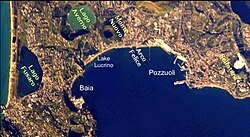Volcanoes/Campi Flegrei
"Campi Flegrei [is] an active four-mile-wide [6.4 kilometer wide] sunken volcano."[1]
"The Campi Flegrei caldera is a supervolcano [as outlined in the image on the right]. Although there’s no picture-postcard volcanic cone, hidden beneath the seemingly placid landscape lies a volcano of immense power. While a new eruption here would be more likely to result in the creation of another Vesuvius-like cone, the worst-case scenario could see it obliterating much of life in Europe."[1]
The image on the right shows the Campi Flegrei caldera circled as a supervolcano relative to Mount Vesuvius, also circled and labeled.
Eruptions
[edit | edit source]"The last time the ground gave way like this, 39,000 years ago when the caldera was formed, it created the cliffs that the postcard town of Sorrento stands on now – volcanic deposits over 300 ft [100 m] deep. If the same kind of eruption happened today, this part of Italy could cease to exist, and the ash clouds would blot out the Sun and lower the Earth’s temperature. Life in the UK as we know it would end. We would lose our livestock, crops and three-quarters of our plant species, plunging us into a new dark age of rioting, starvation and perpetual winter."[1]
Volcanic activity
[edit | edit source]"Right now we may well be in another period of uplift. If it occurs as before, we might expect another 60 years’ worth of unrest, and possible earthquakes and eruptions, with two or three more episodes and uplift to occur in the next ten years. We have to presume we have a few more decades of unrest, and if this is going to be the case, then we have to get more data about the volcano now."[2]
Volcanism
[edit | edit source]




Def. any remnants "of the natural phenomena and processes associated with the action of volcanoes, geysers and fumaroles"[3], especially any remnants of past volcanic activity, are called volcanism.
The image on the right from space of Campi Flegrei shows multiple volcanic cones and crater lakes from the past volcanism.
The second image down on the right is a trachytic dome formed from a lava flow from Solfatara.
The third image down on the right is the massive tuff of Monte Gauro.
Monte di Procida in the fourth image down on the right is a volcanic remnant of Campi Flegrei.
Collina dei Camaldoli, the fifth image down on the right, apparently originated about 35,000 b2k as a result of violent eruptions across Campi Flegrei.
The sixth image down on the right shows Monte Nuovo, a relatively recent cinder cone in the caldera of Campi Flegrei.
The image on the left shows relative relief around Campi Flegrei. This emphasizes that most or all of the relief is due to remnants of volcanic activity. Some of these features are shown in the images on the right.
Hypotheses
[edit | edit source]- The most recent supervolcano eruption of Campi Flegrei left a dust layer in the Greenland ice cores.
See also
[edit | edit source]References
[edit | edit source]- ↑ 1.0 1.1 1.2 Phil Robinson (3 January 2011). Vesuvius's big daddy: The supervolcano that threatens all life in Europe. UK: DailyMail. http://www.dailymail.co.uk/home/moslive/article-1342820/Vesuviuss-big-daddy-supervolcano-Campi-Flegrei-near-Naples-threatens-Europe.html. Retrieved 2015-03-20.
- ↑ Chris Kilburn (3 January 2011). Vesuvius's big daddy: The supervolcano that threatens all life in Europe. UK: DailyMail. http://www.dailymail.co.uk/home/moslive/article-1342820/Vesuviuss-big-daddy-supervolcano-Campi-Flegrei-near-Naples-threatens-Europe.html. Retrieved 2015-03-20.
- ↑ SemperBlotto (5 July 2007). volcanism. San Francisco, California: Wikimedia Foundation, Inc. https://en.wiktionary.org/wiki/volcanism. Retrieved 2015-03-20.
